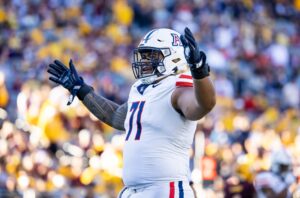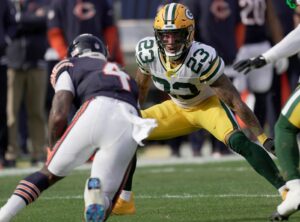At the turn of the decade, the Green Bay Packers had a historically high powered offense. They re-wrote the Packers record book and broke NFL records too. From win streaks to passing records and points scored, the 2011 Packers left an indelible mark on the franchise and NFL record books. However, since those glorious days, the offense has gone off of what made them so lethal.
How Too Much Tempo Hurts the Green Bay Packers Offense
Lack of Creativity in Play-Calling
In 2011, the Packers thrived on personnel groupings and throwing a myriad of formations at their opponents. Aaron Rodgers did not have a go-to guy; he would just scan the field and hit the open receiver. The offense was unstoppable not because of their pace but because they made the defense constantly think and adjust.
Below is a chart showing how many plays per game and total plays the offense has run since 2011 (plays per game come from teamrankings.com, total plays calculated by me). *It should also be noted that in 2017, the offense struggled once Rodgers got injured.
| Seasons | Plays per Game | Total Plays |
| 2011 | 62.4 | 998 |
| 2012 | 64.7 | 1035 |
| 2013 | 66.8 | 1068 |
| 2014 | 62.9 | 1006 |
| 2015 | 66.2 | 1059 |
| 2016 | 64.5 | 1032 |
| 2017* | 62.4 | 998 |
ESPN Green Bay Packers Staff Writer Rob Demovksy published an article in September 2014 on the phenomenon. His piece entitled Packers sacrificing variety to run no-huddle explains that the Packers offense changed for no reason other than to accelerate the pace. The feature shows the Packers lack of creative offensive play-calling by sticking to one offensive set: the Zebra. The Zebra is the three receivers, one tight end, and one running back formation.
In 2010, the Packers called 35.6 percent of their plays out of this formation, but in 2014, the percentage had skyrocketed all the way to 78.4, according to Demovsky’s article.
Evan Tex Western wrote a piece entitled Packers’ Offense by Formation: Struggles in 11 personnel backed up by stats for SB Nation. His piece details that through six games in 2016, the Packers were too reliant on the 11-personnel grouping despite a lack of success out of the formation.
“[…] The Packers have used their 11 personnel (1 RB, 1 TE, 3 WRs) with either Eddie Lacy or James Starks at tailback for the equivalent of more than one entire game – 87 total snaps, or a full 22 percent of their total offensive plays. In addition, the Packers have lined up on first and 10 a total of 160 times so far this year and had 11-personnel on the field for 59 of those plays – an even greater 37 percent. The problem is that when they are in that personnel group on first and 10, they average just 3.7 yards per play, which is second worst in the NFL under those conditions and alignment,” writes Evan ‘Tex’ Western.
The research does not stop here. Evan ‘Tex’ Western analyzes the next most used personnel groupings on first and 10, which are the-10 (1RB, 4WRs), 21 (2RB, 2TE, 1WR) and both of them result in much more gains.
“To put it more plainly, when the Packers line up in 11 on first and ten, the next play is on average second down and 6.3 yards to go. When they line up in 10 or 21 personnel, second down averages 3.7 yards to gain,” writes Evan ‘Tex’ Western.
Pace and Athleticism
In 2013, the Philadelphia Eagles hired offensive guru Chip Kelly from the college ranks. The former Oregon Duck was going to change the NFL forever with his unstoppable-up-tempo-no-huddle offense.
Plenty of things led to his demise, but the no-huddle offense still rules around the NFL. Anytime an unstoppable offense battles an immovable defense, pundits ask the question: will this team go up-tempo and use the no-huddle?
Like with everything else in life, there are pros and cons to using a fast-paced offense. The pros are that the defense gets tired quicker, limit substitutions, unable to make or miss adjustments, which over the course of a game adds up to big plays, sustained drives, touchdowns, and usually wins.
The cons are that if the offense does not score a lot, then the team’s defense will get gassed up and the opposing team’s offense will dissect them.
After Kelly made his debut-season in 2013, Mike McCarthy said he wanted the Packers to run about 75 plays per game per Demovsky. The Packers coach added, “we play pretty fast, but you always want to play faster. With a guy like Aaron, he plays faster than anybody I’ve been around,” said Mike McCarthy in an interview near the end of the offseason program in 2014.
The All-World quarterback backed up the head coach too. “That seems to be the answer to some of the different things that defenses are doing,” said Rodgers during an interview the 2014 off-season.
There are two issues though with the Packers’ no-huddle offense. The first one is the pace of play the second one is versatile athletes or lack thereof.
Pace of Play
The point of running a no-huddle offense is to play faster than usual, but the Packers never really improved their pace of play despite McCarthy’s numerous statements. They bounced back and forth some years they were just outside the top-third and some years they were bottom-third.
| Seasons | Seconds/Play (NFL rank) |
| 2011 | 28.80 (28) |
| 2012 | 27.19 (14) |
| 2013 | 26.69 (11) |
| 2014 | 28.32 (24) |
| 2015 | 26.77 (10) |
| 2016 | 28.37 (25) |
| 2017 | 27.57 (12) |
Numbers courtesy of footballoutsiders.com
The Packers were never able to sustain a fast-paced offense over the course of many seasons. It is possible to maintain such a tempo across seasons as Chip Kelly’s Eagles (’13-’15) and 49ers (’16) ranked number one in four consecutive years.
Versatile Athletes
An offense needs a surgical quarterback and versatile athletes to run 75 plays per game. Green Bay possesses the quarterback in Rodgers.
The versatile athletes leave a lot to be desired. Jordy Nelson and Randall Cobb are not physically the players they were a few years ago. Richard Rodgers’ biggest problem is his lack of athleticism. Lance Kendricks is not a freakish athlete either.
Davante Adams, Aaron Jones, and Jamaal Williams are players that theoretically could play in an up-tempo offense but are they ready to make the jump mentally.
In his piece Sounds crazy, but here’s how Aaron Rodgers, Packers call plays pre-snap, CBS Sports’ Pete Prisco explains how vital the pre-snap communication is for the Packers. “They love to play fast, which means the action at the line of scrimmage is even more important than it is for most offenses,” says Prisco.
A complicated offense playing very fast means that every player needs to know what they do in each play, know the checks, know their brakes. Otherwise, the play will not work.
Conclusion
The Packers are a team in transition. They are about to depart from Cobb, Nelson, and Richard Rodgers and enter the Aaron Jones, Davante Adams, and Jamaal Williams era. The team also boasts some young talents on the practice squad at the wide receiver position. The Packers should slow down the offense this season and play a more similar style to the 2011 team. Throw a myriad of formations and personnel groupings, use newcomers and veterans in mixes, and let the ultimate chef cook up some delicious masterpiece.






